Effect Nitrogen and Humic Acid Levels on Plant Height and Number of Florets per Spike of Gladiolus Cultivars - Juniper Publishers
Juniper Publishers- Open Access Journal of Environmental Sciences & Natural Resources
Effect Nitrogen and Humic Acid Levels on Plant Height and Number of Florets per Spike of Gladiolus Cultivars
Authored by Babar Ali
Abstract
The present research work was conducted at National Agricultural Research Center Islamabad during 2015. The experiment was laid out on Randomized Complete Block Design (RCBD) with ten treatment and four replications having two factors. The first factor was fertigation (control, three Nitrogen levels (44, 64, 86 gram N/m2) and three humic acid levels (250, 350, 500 ppm humic acid/plant.) and three nitrogen and humic acid combinations (44 +250, 64+350, 86 gram N/m2 + 500 ppm Humic acid/plant respectively). The second factor was varieties (Megma Red, Yellow, Pink Rose Suprime and White Prosperity). Maximum number of florets per spike (11.68) in Megma red variety was recorded at 350ppm Humic Acid, while maximum plant height (43.98 cm) in pink rose suprime variety was recorded at 500ppm Humic Acid per plant.
Keywords: Number of Florets; Humic Acid; Gladiolus; Plant Growth Regulators and Plant Height
Introduction
Gladiolus (Gladiolus grandiflorus L.) is belongs to the family of Iridaceae, gladiolus is one the topmost cut flower in all over the world. Gladiolus is derived from the native plants of southland central Africa as well as the Mediterranean region. In the end of sixteen century it was cultivate first time towards. In Indo-Pak, its cultivation dates back to nineteenth century [1]. The gladiolus have a good market value and the flowering bulb used in the home garden and flower. The cultivation of cut flower is one the side income and it generates some parts of world landscaping, as specimen plant used for exhibition and beautification as so lovely and gorgeous colored. The gladiolus is very highly profit-making cut flower species among the cut flowers grown in Baluchistan. The gladiolus market value is depending on the quality of flower and the length of spike [2]. In the different shape of gladiolus is available and hues with good vase life and it have superior bulbous cut flower. A very great demand of gladiolus cut flower in the cut flower industry, which requires the development of novel and great yielding cultivars, and their evaluation for commercial production suitability [3]. In addition, the quality of gladiolas is depending on the soil condition in many arid and semi-arid area of the overall world, where gladiolus is grown in fields [4]. Furthermore, the growth of gladiolus yield and quality of flowers, and corm/cornel production is depending on chemical fertilizers which play a very important role. High levels of fertilization are needed for intensive cut flower production. Improper fertilization in combination with excessive irrigation may contribute pollution to soil, water, and environment [5].
Cultivars showing rapid growth and developing large flower and large plants spikes responds more to fertilizer than those with low vigour and producing smaller spike and plants [6]. According to their store reserve large corms require low fertilizer then small corms and partly to greater feeding power of the extensive root system produced by large corm [7]. The gladiolus is very highly responsive to chemical fertilizers. The nitrogen, phosphorus, potassium with micro-nutrients especially boron and zinc remarkably increase weight and number of corms and cornels per hill [8-10]. In the Soils nitrogen are more very generally deficient than any other element. Because the nitrogen has presented so many essential compounds, the growth is very slow without nitrogen addition [11]. The absence of nitrogen can be clear as a decrease the number of spikes and number of florets per spike in gladiolus as well as the typical pale green foliage [12]. The florets, corms, corm lets and spike length can be developed by Applied of nitrogen with phosphorus [13]. The corm weight and size and number of cornels per plant and improved flower spike length in gladiolus is increase in early by applied nitrogen [14]. The two equal splits of nitrogen are applied at 30 and 60 days after the planting promoted sprouting, spike look and flowering in gladiolus as equaled to a single quantity at planting time, which only improved rachis and length of spike [15]. The polymeric organic compound is a naturally taking place in humic acid, and is a potentially natural resource that can be utilized to increase nutrient availability, growth, and crop yield [16]. The soil, Humus, peat, oxidized wood coal, and coal is from this sources humic acid extract. Humic acid is a commercial product. The HA contains elements that improve the fertility of soil, reduces the deficiency of soil nutrients, and increases nutrient accessibility and water supply by forming various chelates of essential minerals [17,18]. The Humic acid substances (Humic and fulvic acids) constitute organic matter (65-70%) and the different agriculture field studied, because of the multiple role played by these substances, that can benefit emergence of plants [19]. The Humic Acid also upgraded plant environmental stresses and resistance [20]. Previously it was also observed that Humic Acid application is useful for nutrient uptake, particularly for the uptake of N, P, K, Ca, Mg, Cu, Fe, and Zn by plants [21]. The Humic Acid improved nutrient absorption. The positive effects of Humic acid is directly on the plant growth and improve the growth of shoots and roots, absorption of nitrogen, potassium, calcium, magnesium, and phosphorus by plant. Humic acid is consistent with nature and is not dangerous for the plant and environment [22]. The application of humic acid is increases soil aggregation, structure, moisture holding capacity, fertility and the micro-organisms activity are improve[16,23]. Humic Acid application significantly increased photosynthetic efficiency and chlorophyll contents ofrye-grass [24]. It not only promoted the vegetative increment but also increase floral growth as maximum number of florets per spike was produced by plant provided with three application of Humic Acid and NPK [25]. The considering the significance of nutrients in plant structure and physiological processes. They are treated as the limiting factors for good spike, corm and production of cornels in gladiolus [26].
Objectives
In view of the above facts, the present experimental work was designed to achieve the following objectives:
a) To get practical experience of Agriculture research work.
b) To study the adaptability of different gladiolus cultivars under Islamabad conditions.
c) To select a suitable cultivar for Potohar area.
Materials and Methods
The experiment "effect of nitrogen and humic acid levels on Plant height and Nubmer of florets per spike on gladiolus cultivars" was conducted at National Agriculture Research Center Islamabad during 2015. The experiment was laid out in two factorial Replicated complete block design (RCBD) the first factor was fertigation (control, three Nitrogen levels (Control, 44 gm /m2, 64gm / m2, 86 gm / m2.) and three humic acid levels (250 ppm / plant,350 / plant, 500 ppm / plant) and three nitrogen and humic acid levels (44 gm / m2+250 ppm / plant, 64 gm/ m2+350 ppm / plant,86 gm / m2+500 ppm / plant.) and the second factor was varieties (Megma Red, Yellow, Pink Rose Suprime and White Prosperity) the experiment was replicated four times. The experiment was consisting of following treatments.
a) T1= Control.
b) T2= 44 gram nitrogen / meter square.
c) T3= 64 gram nitrogen / meter square.
d) T4= 86 gram nitrogen / meter square.
e) T5= 250 ppm Humic acid / plant.
f) T6= 350 ppm Humic acid / plant.
g) T7= 500 ppm Humic acid / plant.
h) T8= 44 gram N / meter square+250 ppm Humic acid / plant.
i) T9= 64 gram N / meter square+350 ppm Humic acid /plant.
j) T 10= 86 gram N / meter square+500 ppm Humic acid / plant.
Research Parameters
The data was collected on the following parameters:
Plant height (cm): Three plants were selected from each treatment randomly and Plant height was measured by using meter scale. Plant height was measured from the surface of the soil to the tip of the spike and then average was calculated.
Number of florets spike-1: The number of florets spike-1 of three different randomly selected plants was counted, and then average was calculated for further statistical analysis.
Statistical analysis: The data recorded were analyzed statistically using Micro soft excel and statistix-8.1. The least significant difference (LSD) test was applied to test the significance of difference.
Results and Discussion
In the present work the effect of Nitrogen and Humic Acid levels on Plant height and No of florets per spike of gladiolus cultivars was studied at National Agriculture Research Center Islamabad. We recorded and analyzed data on different parameters. The details of each parameter are as:
Plant height
The data regarding effect of Nitrogen and Humic Acid levels on plant height is presented in (Figure 1), and the Analysis of Variance (ANOVA) is presented in (Table 1). The statistical analysis shows that the plant height of different gladiolus varieties was significantly affected by different concentrations of nitrogen and humic acid. Maximum plants height (43.98 cm) was recorded in response to T6 (350 ppm Humic acid / plant) while minimum plants height (37.03 cm) observed in response to T9 (64 gm N/m2+350 ppm Humic acid / plant). In case of varieties Maximum plants height (48.98 cm) was recorded in Pink Rose, and minimum plants height was observed in the variety yellow. The interaction effect showed that pink rose suprime in T6 (350 ppm Humic acid / plant) attained maximum number of plant height, while the variety yellow in T6 (350 ppm Humic acid / plant) showed minimum number of plant height.
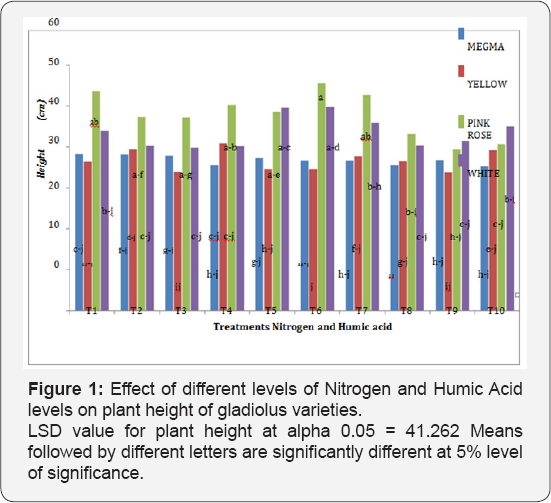
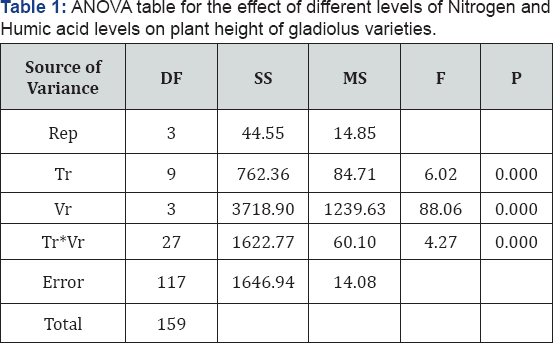
Plant height correlated with application of nitrogen and Humic acid dose because use of Humic acid and bio-fertilizers is proposed to modify soil texture, soil structure integrity, aeration and Increase nutrient absorption. Humic acid is a commercial product containing abundant nutrients improves soil fertility and increase the availability of nutrients to plants and thus it influences plant growth and yield. Humic acid (HA) is a naturally occurring polymeric organic compound, and is a potential natural resource, that can be utilized to enhance plant growth, availability of nutrients and yield. LSD value for plant height at alpha 0.05 = 41.262 Means followed by different letters are significantly different at 5% level of significance.
Number of Florets per Spike
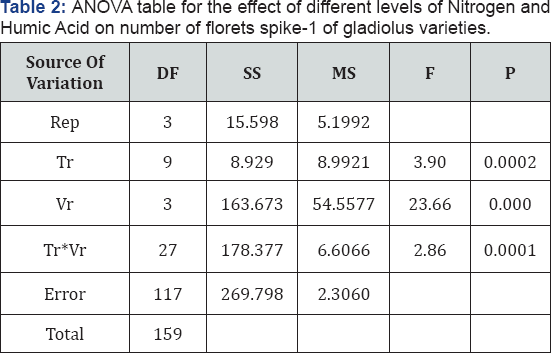
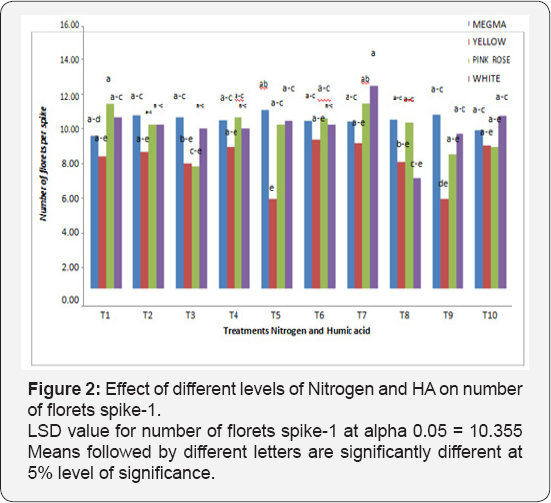
The data regarding effect of different levels of Nitrogen and HA on number of florets spike-1 is presented in (Figure 2), and ANOVA is presented in (Table 2). The statistical analysis showed that the number of florets per spike of different gladiolus varieties was significantly affected by different levels of nitrogen and humic acid (Table 1). Maximum number of florets (11.68) per spike was recorded in response to T7 (500 ppm Humic acid / plant), while minimum number of florets (9.39) per spike was observed in response to T3 (64 gm N/m2). In case of varieties maximum number of florets was recorded in Megma red, and minimum number of florets was observed in Yellow variety. The interaction effect showed that white prosperity in T7 (500 ppm Humic acid / plant) attained maximum number of florets per spike, while magma red in T4 (86 gm N/ m2) show minimum number of florets per spike [27-37]. Observed that the N and P2O5 dose 175+200 kg/ha produced significantly maximum number (14.00) of florets per spike. They concluded that for obtaining maximum number of florets spike-1, number of corms per plant, number of corm lets per corm and longer spike length application of nitrogen and phosphorus at 175+200 kg/ha may be applied [37-40].
Conclusion
It was concluded from the results noted that nitrogen and Humic Acid play an important role in growth and flowering of gladiolus plant. Though nitrogen and Humic Acid had significant effect on the vegetative and reproductive mode of gladiolus plant but highly desirable results can be obtained from combination of both the elements. It was also noted that balance combination of both the elements have very good effect on the plant growth, yield and quality of flowers. Best results were recorded from treatment T5, T6 and T7 where 250ppm, 350ppm and 500ppm Humic Acid per plant was applied respectively which gave maximum number of florets per spike (11.68), spike plant height (43.98 cm) etc.
For more articles in Open Access Journal of Environmental Sciences & Natural Resources please click on: https://juniperpublishers.com/ijesnr/index.php



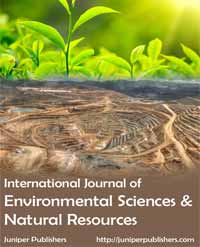
Comments
Post a Comment